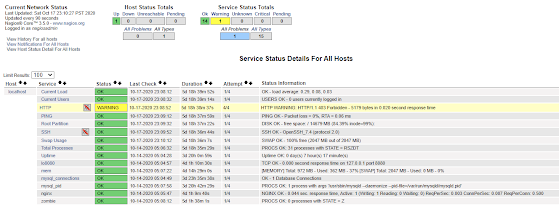Nagios offers monitoring and alerting services for your business infrastructures like servers, switches, applications and services. Adding a graph to Nagios is necessary for effective monitoring especially to predict possible attacks on your servers. PNP4Nagios is a plugin for Nagios for creating graphs.
Click here to learn how to install Nagios Core.
Step 1: Install all required package
yum install rrdtool perl-Time-HiRes rrdtool-perl php-gd -y
Step 2: Download the source and extract
cd /tmp
wget https://sourceforge.net/projects/pnp4nagios/files/latest/download/pnp4nagios-0.6.26.tar.gz
tar zxfv pnp4nagios-0.6.26.tar.gz
Step 3: Compile and Install
cd pnp4nagios-0.6.26
./configure
make all
make fullinstall
Step 4: Setup the NPCD
Change config to run npcd only on level 3 and 5. Change also the install.php filename.
chkconfig --add npcd && chkconfig --level 35 npcd on
service httpd reload
Check the URL http: // server / pnp4nagios / to make sure pnp4nagios has been installed. If all green and pass then proceed.
Backup install.php
mv /usr/local/pnp4nagios/share/install.php /usr/local/pnp4nagios/share/install.php-ori
Step 5: Edit nagios.cfg, and add this at the bottom of the file
vi /usr/local/nagios/etc/nagios.cfg
[Esc]+ GA – to edit the bottom of the file
# Bulk / NPCD mode
process_performance_data=1
service_perfdata_file=/usr/local/pnp4nagios/var/service-perfdata
service_perfdata_file_template=DATATYPE::SERVICEPERFDATA\tTIMET::$TIMET$\tHOSTNAME::$HOSTNAME$\tSERVICEDESC::$SERVICEDESC$\tSERVICEPERFDATA::$SERVICEPERFDATA$\tSERVICECH$
service_perfdata_file_mode=a
service_perfdata_file_processing_interval=15
service_perfdata_file_processing_command=process-service-perfdata-file
host_perfdata_file=/usr/local/pnp4nagios/var/host-perfdata
host_perfdata_file_template=DATATYPE::HOSTPERFDATA\tTIMET::$TIMET$\tHOSTNAME::$HOSTNAME$\tHOSTPERFDATA::$HOSTPERFDATA$\tHOSTCHECKCOMMAND::$HOSTCHECKCOMMAND$\tHOSTSTATE::$ host_perfdata_file_mode=a
host_perfdata_file_processing_interval=15
host_perfdata_file_processing_command=process-host-perfdata-file
[Esc] :wq
Step 6: Edit commands.cfg
vi /usr/local/nagios/etc/objects/commands.cfg
[Esc]+ GA
define command{
command_name process-service-perfdata-file
command_line /bin/mv /usr/local/pnp4nagios/var/service-perfdata /usr/local/pnp4nagios/var/spool/service-perfdata.$TIMET$
}
define command{
command_name process-host-perfdata-file
command_line /bin/mv /usr/local/pnp4nagios/var/host-perfdata /usr/local/pnp4nagios/var/spool/host-perfdata.$TIMET$
}
Step 7: Edit templates.cfg and add host-pnp & srv-pnp
vi /usr/local/nagios/etc/objects/templates.cfg
define host {
name host-pnp
action_url /pnp4nagios/index.php/graph?host=$HOSTNAME$&srv=_HOST_' class='tips' rel='/pnp4nagios/index.php/popup?host=$HOSTNAME$&srv=_HOST_
register 0
}
define service {
name srv-pnp
action_url /pnp4nagios/index.php/graph?host=$HOSTNAME$&srv=$SERVICEDESC$' class='tips' rel='/pnp4nagios/index.php/popup?host=$HOSTNAME$&srv=$SERVICEDESC$
register 0
}
Put the host-pnp on every host like this:
define host{
use linux-server,host-pnp
host_name localhost
alias localhost
address 127.0.0.1
}
Put the srv-pnp on every service like this:
define service{
use local-service,srv-pnp
host_name localhost
service_description PING
check_command check_ping!100.0,20%!500.0,60%
}
Step 8: Copy the status-header and restart services
Copy this file in the /usr/local/nagios/share/ssi/ for mouseover graph
cp contrib/ssi/status-header.ssi /usr/local/nagios/share/ssi/
Then restart npcd,httpd and nagios
service npcd restart
service httpd restart
service nagios restart







